Snailbeach Lead Mine Today |
||
Current Developments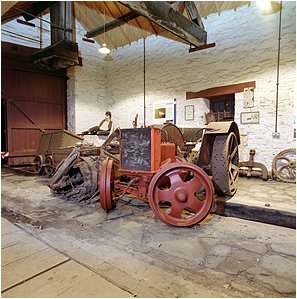 Today the mine site is owned by Shropshire County Council and managed by Shropshire Mines Trust. The "Miners Dry" has been restored and now houses an interpretation centre, which can be opened for organised tours, as can the blacksmith's workshop and locomotive shed. Short "walk in" underground experiences can be provided by the Shropshire Mines Trust, but for experienced underground explorers it is best to contact Shropshire Caving & Mining Club who control access to the lower levels of the mine. Today the mine site is owned by Shropshire County Council and managed by Shropshire Mines Trust. The "Miners Dry" has been restored and now houses an interpretation centre, which can be opened for organised tours, as can the blacksmith's workshop and locomotive shed. Short "walk in" underground experiences can be provided by the Shropshire Mines Trust, but for experienced underground explorers it is best to contact Shropshire Caving & Mining Club who control access to the lower levels of the mine.With the exception of the Halvens Engine House, which was demolished in 1985, the rest of the mine buildings remain standing, largely in a derelict state. Up until relatively recently many of the buildings still clung onto their roofs, unfortunately neglect and the ravages of the weather took their toll and by the time the council came to conserve the site in the 1990's the roof timbers had given way. The blacksmith's workshop has been restored and now contains a selection of tools and equipment that allow demonstrations to take place during the national "Heritage Open Days" held in September each year, although visitors are welcome to walk around the site at any time.
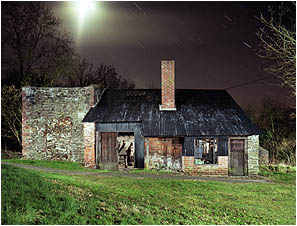 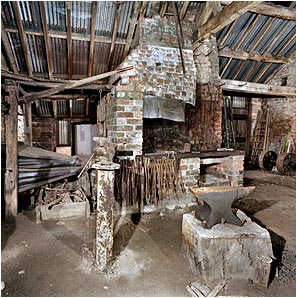 It is requested that visitors to the mine park in the village hall car park, the site of the barytes processing plant erected in the late 1890's. Just below the car park it's possible to see the route of the Snailbeach & District Light Railway (now a children's play area) and the bridge that carries the road across the track bed is still in place, although largely hidden by backfilling. Following the footpath from the car park up the hill it is hard to imagine that the pleasant green pasture land on the left is all that remains of the stark white tips that provided employment for successive companies from 1900 until 1985, the foundations of the Halven's engine house are passed half way up.
Still On View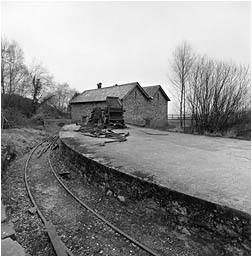 On reaching the top of the footpath the rails from the Snailbeach & District Light Railway are encountered. Although resurfacing of the road has covered a short section it is still possible to follow rails in both directions either side of the road. To the right lies the locomotive shed and under a layer of dirt the points, complete with operating levers, that allowed locomotives access to the shed. The building itself contains two tracks with inspection pits and smoke hoods on both. Steam operation on the railway ceased in 1946 and the locomotives remained until May 1950, when they were cut up on site by Thos. W. Ward Ltd. The shed now contains artefacts and machinery collected from across the site, including the remains of two trucks that worked on the railway. 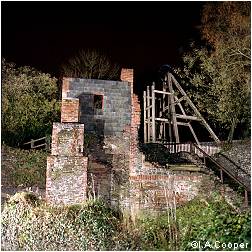 Following the footpath to the right of the locomotive shed leads to George's Shaft, and a reconstructed head frame errected in 1999. To the right of the head frame is the restored blacksmiths workshop. Also in this area is the entrance to "Day Level", this short tunnel travels in a straight line for a few hundred yards until it meets the main pumping shaft, which breaks out to surface further up the hill. Rather than wind ore all the way to the top of the shaft, only to transport it back down to the mine buildings again on the surface, the level was dug to meet the shaft. Ore would be wound up as far as Day Level before being taken out to be processed. 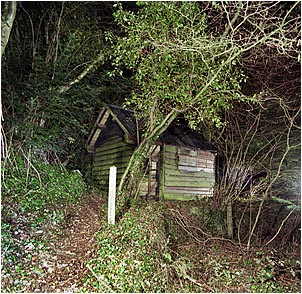 Wandering around the site it's possible to see the remains of many of the buildings, whilst hidden in some of the less obvious areas are winches, engine beds, kibbles and other machinery. The water level in the reservoir has been lowered since the closure of the mine, but still holds water. The obvious chimney located high on Lordshill isn't actually directly connected to the mine itself, the chimney was linked to the smelt house, built in 1863, and remains of the flue connecting the two can still be traced in places. The Cornish pumping engine installed to pump water from the mine in 1857 was originally provided with it's own chimney, at some point this was demolished and a flue built to connect the boilers to the smelter chimney located just a short distance further up the hillside, this can be traced quite easily as it's collapsed in this area. Underground Remains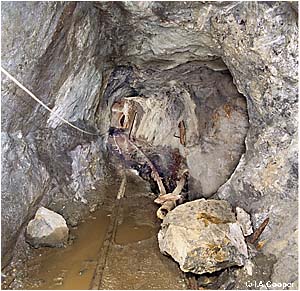 Although trips into both Day Level and Perkins Level can be arranged through Shropshire Mines Trust, it takes specialist underground exploration techniques to reach the remains on the lower levels of the mine. Entering through Perkins Level it's possible to link into the end of the main stope, a gash through the hillside that's about 1,000 yards long and 1,656 feet deep, although 1,320 feet of the workings have been hidden under water since pumping stopped in 1911. Even when you're in the stope it's not possible to look vertically straight down to the bottom as the workings are at a slight angle. Exploration now consists mainly of passing through the remains of old levels and high chambers that connect into the end of the main stope. 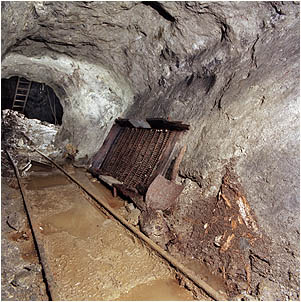 The majority of interesting remains are to be found on the 40 yard level, this is measured from the collar of George's Shaft, itself a couple of hundred feet lower than Perkin's Level, the current access point into the mine workings. The 40 yard level used to form the main tramming level and still contains railway tracks along most of it's accessible length. Scattered along the level are various tools: Shovels, drills, powder flasks, saws etc. The main highlights are two trucks that have been abandoned, unfortunately the conditions underground have changed in recent times and it's much more humid than it used to be, this has taken it's toll on the truck's condition and great care needs to be exercised near them as their timber structure easily disintegrates. 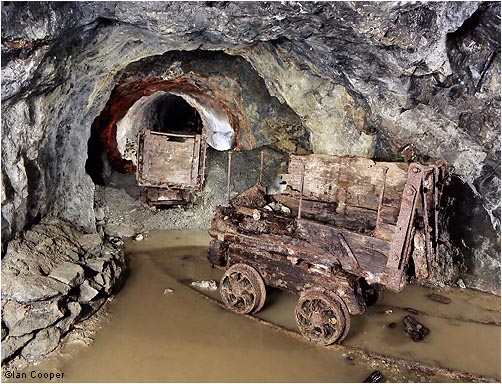 |
||
| All photographs are the work and copyright of Ian Cooper. | ||
